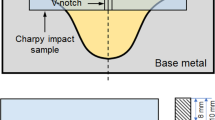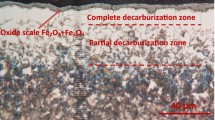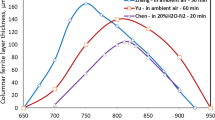Abstract
By employing CaF2-SiO2 and CaF2-SiO2-MnO system fluxes, the roles of SiO2 and MnO in decarburization behaviors during submerged arc welding of EH36 shipbuilding steel have been quantified and evaluated. All possible reactions associated with C transfer and interfaces at which these reactions occur are systematically discussed. It is concluded that the addition of SiO2 and MnO exerts synergistic effects on the extent of decarburization due to increased partial pressures of O2 and SiO gases in the plasma, improved O level in the weld pool, and higher activities of the oxides, such as SiO2, MnO, and FeO, at the slag–metal interface. The investigation over the macrographic detached slag surfaces shows that the possibility of bubble nucleation is highly influenced by flux formula. The effect of heat input on decarburization is discussed, and the optimal flux compositions expected in the present study are analyzed.




Similar content being viewed by others
References
C. Chai: Slag–Metal Reactions during Flux Shielded Arc Welding, Massachusetts Institute of Technology, Cambridge, MA, 1980.
D. Loder, S. Michelic, A. Mayerhofer and C. Bernhard: Metall. Mater. Trans. B, 2017, vol. 48, pp. 1992–2006.
G. Evans: Weld. J., 1983, vol. 19, pp. 133–320.
R. Farrar and P. Harrison: J. Mater. Sci. 1987, vol. 22, pp. 3812–3820.
S. Kou: Welding Metallurgy, 2nd ed.,Wiley & Sons, New York, NY, 2003, pp. 22–95.
V. Sengupta, D. Havrylov and P. Mendez: Weld. J., 2019, vol. 98, pp. 283–313.
T. Lau, G. Weatherly and A. McLean: Weld. J., 1985, vol. 64, pp. 343–347.
J. Indacochea, M. Blander, N. Christensen and D. Olson: Metall. Trans. B, 1985, vol. 16, pp. 237–245.
U. Mitra and T. Eagar: Metall. Trans. B, 1991, vol. 22, pp. 83–100.
C. Natalie, D. Olson and M. Blander: Ann. Rev. Mater. Sci., 1986, vol. 16, pp. 389–413.
C. Chai and T. Eagar: Weld. J., 1982, vol. 61, pp. 229–232.
T. Eagar: Weld. J., 1978, vol. 57, pp. 76–80.
K. Bang, C. Park, H. Jung and J. Lee: Met. Mater. Int., 2009, vol. 15, pp. 471–477.
T. Lau, G. Weatherly and A. McLean: Weld. J., 1986, vol. 65, pp. 343–347.
U. Mitra: Kinetics of Slag Metal Reactions during Submerged Arc Welding of Steel, Massachusetts Institute of Technology, Cambridge, MA, 1984.
J. Zhang, T. Coetsee and C. Wang: Metall. Mater. Trans. B, 2020, vol. 51, pp. 16–21.
J. Zhang, T. Coetsee, H. Dong and C. Wang: Metall. Mater. Trans. B, 2020, 10.1007/s11663-020-01821-z.
C. Chai and T. Eagar: Metall. Trans. B, 1981, vol. 12, pp. 539–547.
U. Mitra and T. Eagar: Metall. Trans. A, 1984, vol. 15, pp. 217–227.
U. Mitra and T. Eagar: Metall. Trans. B, 1991, vol. 22, pp. 73–81.
U. Mitra and T. Eagar: Metall. Trans. B, 1991, vol. 22, pp. 65–71.
J. Zhang, J. Leng and C. Wang: Metall. Mater. Trans. B, 2019, vol. 50, pp. 2083–2087.
C. Dallam, S. Liu and D. Olson: Weld. J., 1985, vol. 64, pp. 140–151.
D. Olson, S. Liu, R.H. Frost, G. Edwards and D. Fleming: Nature and Behavior of Fluxes Used for Welding, ASM Handbook, Materials Park, OH, 1993, vol. 6, pp. 43–54.
P. Burck, J. Indacochea and D. Olson: Weld. J., 1990, vol. 3, pp. 115–122.
F. Richardson: Proc. Int. Symp. on Chem. Metall. of Iron and Steel, 1973, pp. 82–92.
U.T. Gonzenbach, A.R. Studart, E. Tervoort and L.J. Gauckler: J. Am. Ceram. Soc., 2007, vol. 90, pp. 16–22.
K.C. Mills: Slag Atlas, 2nd ed., Verlag Stahleisen GmbH, Düsseldorf,1995.
S. Hara and K. Ogino, ISIJ Int., 1992, vol. 32, pp. 81–86.
K. Mills and B. Keene, Int. Met. Rev., 1981, vol. 26, pp. 21–-69.
S. Tuliani, T. Boniszewski and N. Eaton: Welding & Metal Fabrication, 1969, vol. 37, pp. 327–339.
J. Ito and M. Nakanishi: Sumitomo Search, 1976, pp. 42–62.
C. Bale, P. Chartrand, S. Degterov, G. Eriksson, K. Hack, R. Mahfoud, J. Melançon, A. Pelton and S. Petersen: Calphad, 2002, vol. 26, pp. 189–228.
L. Coudurier, D. Hopkins and I. Wilkomirsky: Fundamentals of Metallurgical Processes, 2nd ed., Pergamon Press, Oxford, 1985, pp. 265–274.
K. Sasai and Y. Mizukami: ISIJ Int., 1996, vol. 36, pp. 388–394.
B. Rao and D. Gaskell: Metall. Trans. B, 1981, vol. 12, pp. 311–317.
Acknowledgments
We thank the National Natural Science Foundation of China (Grant Nos. 51622401, 51861130361, 51861145312, and 51850410522), Newton Advanced Fellowship by the Royal Society (Grant No. RP12G0414), Research Fund for Central Universities (Grant Nos. N172502004, N2025025), Xingliao Talents Program (XLYC1807024 and XLYC1802024), Liaoning Key Industrial Program (2019JH1/10100014), The Innovation Team of Northeastern University, and Global Talents Recruitment Program endowed by the Chinese government for their financial support. We thank the State Key Laboratory of Solidification Processing, Northwestern Polytechnical University (Grant No. SKLSP201805), Shagang Steel, and Lincoln Electric China. This work is also funded in part by the National Research Foundation of South Africa (BRICS171211293679).
Author information
Authors and Affiliations
Corresponding author
Additional information
Publisher's Note
Springer Nature remains neutral with regard to jurisdictional claims in published maps and institutional affiliations.
Manuscript submitted March 16, 2020.
Appendix A: ΔG Calculations for Possible Decarburization Reactions in Submerged Arc Welding
Appendix A: ΔG Calculations for Possible Decarburization Reactions in Submerged Arc Welding
The ΔG values of possible decarburization reactions were calculated by FactSage 6.4.[33] The reaction module in FactSage was applied using FToxid, FSstel, and FactPS databases. The ΔG values for the reactions were adjusted to present dilute solute concentrations of C, Si, O, and Mn at one mass percent reference state in liquid Fe by using the free energy of solution values from the literature.[34] The calculations were performed from 1773 (melting point of iron) to 2573 K (temperature of the hot spot at the arc root).[24] The ΔG values were calculated with the following assumptions and summarized in Figure A1.
-
1.
The setting of partial pressures of gases (O2, SiO, and CO) was based on the fact that their partial pressures in the plasma are much smaller than unity.[15]
-
2.
The \( P_{{{\text{O}}_{2} }} \) value of 2.57 × 10–5 atm is the equilibrium \( P_{{{\text{O}}_{2} }} \) for the FeO-Fe system at 2573 K with unit activities of FeO and Fe.[35]
-
3.
The setting of maximum activities of SiO2 and MnO expected in CaF2-free flux (Flux F-12) was based on the assumption that the addition of CaF2 to the flux has a dilution effect on MnO and may react with SiO2 (via Reaction [A1]) to lower their activities in the slag.[11,16] The activities of SiO2 and MnO were referenced from the work of Rao and Gaskell,[36] as it was reported that activity data of steelmaking could be used in SAW in terms of thermodynamic analysis.[18,23,25]
$$ 2({\text{CaF}}_{2} ) + ({\text{SiO}}_{2} ) = 2({\text{CaO}}) + {\text{SiF}}_{4} ({\text{g}}) $$(A1) -
4.
The setting of FeO activity was based on the approximate FeO level analyzed in the post-weld slags in our previous studies, assuming the ideal behavior of FeO in the slags at low FeO concentrations.[16,17]
Rights and permissions
About this article
Cite this article
Zhang, J., Coetsee, T., Dong, H. et al. Elucidating the Roles of SiO2 and MnO upon Decarburization During Submerged Arc Welding: A Thermodynamic Study into EH36 Shipbuilding Steel. Metall Mater Trans B 51, 1805–1812 (2020). https://doi.org/10.1007/s11663-020-01869-x
Received:
Published:
Issue Date:
DOI: https://doi.org/10.1007/s11663-020-01869-x





